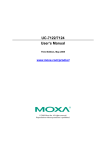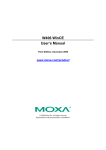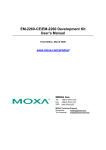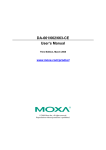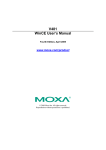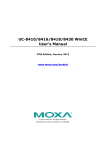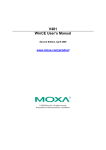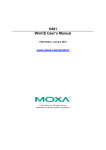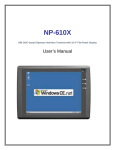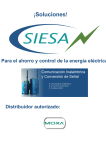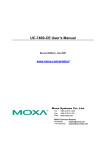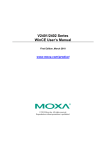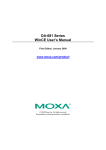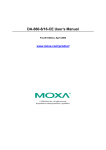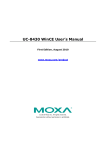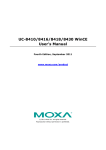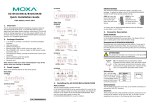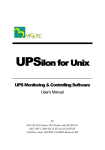Download UC-7122/7124 User`s Manual, v1
Transcript
UC-7122/7124 User’s Manual First Edition, July 2007 www.moxa.com/product Moxa Systems Co., Ltd. Tel: +886-2-2910-1230 Fax: +886-2-2910-1231 Web: www.moxa.com MOXA Technical Support [email protected] Worldwide: The Americas: [email protected] UC-7122/7124 User’s Manual The software described in this manual is furnished under a license agreement and may be used only in accordance with the terms of that agreement. Copyright Notice Copyright © 2007 Moxa Systems Co., Ltd. All rights reserved. Reproduction without permission is prohibited. Trademarks MOXA is a registered trademark of the Moxa Group. All other trademarks or registered marks in this manual belong to their respective manufacturers. Disclaimer Information in this document is subject to change without notice and does not represent a commitment on the part of MOXA. MOXA provides this document “as is,” without warranty of any kind, either expressed or implied, including, but not limited to, its particular purpose. MOXA reserves the right to make improvements and/or changes to this manual, or to the products and/or the programs described in this manual, at any time. Information provided in this manual is intended to be accurate and reliable. However, MOXA assumes no responsibility for its use, or for any infringements on the rights of third parties that may result from its use. This product might include unintentional technical or typographical errors. Changes are made periodically to the information in this manual to correct such errors, and these changes are incorporated into new editions of the publication. Table of Contents Chapter 1 Introduction ..................................................................................................1-1 Overview.................................................................................................................................. 1-2 Model Descriptions and Package Checklist.................................................................. 1-2 UC-7122/7124 Features................................................................................................ 1-2 Hardware Specifications............................................................................................... 1-3 UC-7122/7124 Software .......................................................................................................... 1-4 Applications Development Environment...................................................................... 1-4 Networking and Communications Capabilities ............................................................ 1-4 Supported Servers and Daemons .................................................................................. 1-5 Obtaining the Firmware Build Version .................................................................................... 1-5 Memory and File Systems ....................................................................................................... 1-5 RAM File System ......................................................................................................... 1-5 Flash File System.......................................................................................................... 1-6 External File System..................................................................................................... 1-6 Cautions when Using File Systems .............................................................................. 1-6 Using a RAM File System instead of a Flash File System ........................................... 1-6 Hive-based Registry................................................................................................................. 1-6 Inserting an SD Card into the Computer.................................................................................. 1-7 Connecting a USB Mass Storage Device to the Computer ...................................................... 1-7 RS-232/422/485 Serial Ports.................................................................................................... 1-8 Chapter 2 Getting Started .............................................................................................2-1 Starting Your UC-7122/7124 Computer .................................................................................. 2-2 Resetting Your UC-7122/7124 Computer ................................................................................ 2-2 Operating Your UC-7122/7124 Computer through the Serial Console.................................... 2-3 Changing the Network Settings ............................................................................................... 2-3 Operating Your UC-7122/7124 Computer through a Telnet Client.......................................... 2-4 User/Group Management......................................................................................................... 2-5 System Time Management....................................................................................................... 2-6 Starting and Stopping Services ................................................................................................ 2-6 Troubleshooting Network Connectivity................................................................................... 2-6 Simple Network Management Protocol (SNMP)..................................................................... 2-7 Chapter 3 Web-based Management System ...............................................................3-1 Logging onto the Web-based Management System ................................................................. 3-2 System Information.................................................................................................................. 3-2 Networking/Server Configuration............................................................................................ 3-3 Serial Port Configuration ......................................................................................................... 3-3 Monitoring and Controlling Services....................................................................................... 3-4 Monitoring and Controlling Processes (Threads) .................................................................... 3-5 Launching Processes Automatically ........................................................................................ 3-5 Appendix A Firmware Upgrade Procedure.................................................................... A-1 Appendix B Frequently Asked Questions ..................................................................... B-1 1 Chapter 1 Introduction The UC-7122/7124 are pocket size embedded computers with 2 or 4 serial ports, dual 10/100 Mbps Ethernet, an SD socket, and a USB 2.0 host port. The UC-7122/7124 are ideal for front-end device monitoring, data acquisition, and protocol conversion. Wide temperature models are also available to provide reliable performance in harsh operating environments. The RISC-based UC-7122/7124 embedded computers come with the Windows® CE operating system pre-installed. Microsoft® Windows® CE 5.0 is an open, scalable, 32-bit operating system that allows users to build a wide range of innovative, small footprint devices. A typical Windows® CE-based device is designed for a specific use, and often runs disconnected from other computers, or distributed as a front-end to a centralized host. Examples include enterprise tools, such as industrial controllers, communications hubs, point-of-sale terminals, and display devices, such as HMI, advertisement appliances, and interactive panels. The following topics are covered in this chapter: Overview ¾ Model Descriptions and Package Checklist ¾ UC-7122/7124 Features ¾ Hardware Specifications UC-7122/7124 Software ¾ Applications Development Environment ¾ Networking and Communications Capabilities ¾ Supported Servers and Daemons Obtaining the Firmware Build Version Memory and File Systems ¾ RAM File System ¾ Flash File System ¾ External File System ¾ Cautions when Using File Systems ¾ Using a RAM File System instead of a Flash File System Hive-based Registry Inserting an SD Card into the Computer Connecting a USB Mass Storage Device to the Computer RS-232/422/485 Serial Ports UC-7122/7124 User’s Manual Introduction Overview The UC-7122/7124 embedded computers come with 2 or 4 RS-232/422/485 serial ports and dual 10/100 Mbps Ethernet LAN ports to provide users with a versatile communication platform, making these RISC-based embedded computers ideal for your embedded applications. The UC-7122/7124 embedded computers use the Cirrus Logic EP9302 ARM9 200 MHz RISC CPU. Unlike the X86 CPU, which uses a CISC design, the ARM9’s RISC design architecture and modern semiconductor technology provide the UC-7122/7124 with a powerful computing engine and communication functions, but without generating too much heat. Moreover, the built-in 16 MB NOR Flash ROM and 32 MB SDRAM give you enough storage capacity to run applications on the UC-7122/7124. The additional SD socket provides the flexibility for storage expansion, and the dual LAN ports built into the ARM9 make the UC-7122/7124 ideal communication platforms for simple data acquisition and protocol conversion applications. In addition, the RS-232/422/485 serial ports allow you to connect a variety of serial devices. Taken together, these features ensure that the UC-7122/7124 embedded computers are convenient and powerful central control units for industrial applications, such as data acquisition, remote device control and monitoring, and protocol conversion. Model Descriptions and Package Checklist UC-7124-CE Mini RISC-based, Ready-to-Run Embedded Computer with Dual LANs, 4 Serial Ports, SD, USB, WinCE 5.0 UC-7122-CE Mini RISC-based, Ready-to-Run Embedded Computer with Dual LANs, 2 Serial Ports, SD, USB, WinCE 5.0 Each model is shipped with the following items: y y y y y y y 1 UC-7122/7124 embedded computer Quick Installation Guide Document & Software CD 100 cm RJ45-to-RJ45 Ethernet cross-over cable CBL-4PINDB9F-100: 100 cm console port cable, 4-pin header to female DB9 Universal Power Adaptor Product Warranty Statement Optional Accessories y 35 mm DIN-rail mounting kit (DK-35A) NOTE: Please notify your sales representative if any of the above items are missing or damaged. UC-7122/7124 Features The UC-7122/7124 embedded computers have the following features: y y y y y Cirrus Logic EP9302 ARM9 32-bit 200 MHz processor 32 MB on-board RAM 16 MB built-in flash memory RS-232/422/485 serial ports with software selectable interface Baudrates between 50 and 921.6Kbps; supports ANY BAUDRATE 1-2 UC-7122/7124 User’s Manual y y y y y y y Introduction Dual 10/100 M Ethernet for backup networking SD card slot for storage expansion LED indicators for status, serial transmission Ready-to-run WinCE platform Easy DIN-rail or wall mounting Fanless design for increased ruggedness -40 to 75°C wide temperature models available Hardware Specifications System CPU Cirrus Logic EP9302 ARM9 RISC CPU, 200 MHz RAM 32 MB Flash 16 MB Storage Expansion SD slot USB USB2.0 host x 1 Console port RS-232 x 1 (TxD, RxD, GND), 4-pin header output, “115200, n, 8, 1” Button Reset button x 1; supports “Reset to Factory Default” Other RTC, buzzer, Watchdog Timer OS Built-in WinCE 5.0 Network Communication LAN 10/100 Mbps RJ45 x 2, auto-sensing Protection 1.5 KV built-in magnetic isolation protection Serial Communication Serial Ports UC-7122: RS-232/422/485 male DB9 x 2 UC-7124: RS-232/422/485 male DB9 x 4 Protection 15 KV built-in ESD protection for all signals Data bits 5, 6, 7, 8 Stop bit(s) 1, 1.5, 2 Parity None, Even, Odd, Space, Mark Flow Control RTS/CTS, XON/XOFF, RS-485 ADDC™ Speed 50 bps to 921.6Kbps; supports ANY BAUDRATE LEDs System Ready, SD activity LAN 10M/Link, 100M/Link (RJ45 connector) Serial TxD, RxD Power Requirements Power Input 12 to 48 V Power Consumption (Without USB device plugged in) UC-7122: 340 mA @ 12 VDC UC-7124: 360 mA @ 12 VDC (With USB device plugged in) UC-7122: 667 mA @ 12 VDC UC-7124: 700 mA @ 12 VDC Mechanical Dimensions UC-7122/7124: 77 x 111 x 26 mm (without wall mount ears) (W x D x H) Construction Material UC-7122/7124: aluminum, 1 mm 1-3 UC-7122/7124 User’s Manual Mounting Environment Operating Temperature Storage Temperature Introduction DIN-rail, wall -10 to 60°C (14 to 140°F), 5 to 95% RH -40 to 75°C (-40 to 167°F) is optional for –T models -20 to 80°C (-4 to 176°F), 5 to 95% RH -40 to 85°C (-40 to 185°F) is optional for –T models Regulatory Approvals EMC FCC, CE (Class A) Safety UL, cUL Others RoHS, CRoHS, WEEE Warranty 5 years NOTE: (1) The USB Client function is reserved for future enhancement. (2) CompactFlash is designed for Flash memory cards or Microdrives. UC-7122/7124 Software The UC-7122/7124 embedded computer is a ready-to-run, RISC-based, “headless” computer with a robust and network-centric design. It uses the Microsoft® Windows® CE 5.0 operating system. Developers of embedded communication applications will find that the open programming environment makes the UC-7122/7124 well-suited for both new system development and legacy system migration. Applications Development Environment y C Libraries and Run-times—Compared to the C libraries and run-times used on a desktop PC running Windows®, the C libraries and run-times on a UC-7122/7124 WinCE are a subset of the WIN32 APIs. The system supports a full ANSI C run-time, standard input/output library, standard input/output ASCII library, and standard ASCII string functions. In addition, C++ compiler exception handling and Run-Time Type Information (RTTI) equivalent to desktop C++ compilers are supported. y Component Services (COM and DCOM)—The Common Object Model (COM) is an operating system-independent, object-oriented system for creating binary software components that can interact with other COM-based components in the same process space, in other processes, or on remote machines. y Microsoft® Foundation Classes (MFC)—MFC is a comprehensive class library and complete object-oriented application framework designed to help build applications, COM components, and controls. y Winsock 2.2—Provides enhanced capabilities over Winsock 1.1, including installable service providers for additional third-party protocols, and Media sense. Networking and Communications Capabilities y Simple Network Management Protocol (SNMP)—Monitors remote connections to the network. y Simple Network Time Protocol (SNTP) Client—Provides support for synchronizing the device’s system time with an SNTP server, and supports Daylight Savings Time. y Serial Communications—In addition to the 16550 UART driver bound to a debug port and the console port, a special driver for 8 or 16 additional MOXA serial ports is also included. y Network Utilities (IpConfig, Ping, Route)—Utilities for troubleshooting various network problems. y TCP/IP—Includes IP, Address Resolution Protocol (ARP), Internet Control Message Protocol (ICMP), Internet Group Membership Protocol (IGMP), Transmission Control Protocol (TCP), 1-4 UC-7122/7124 User’s Manual Introduction User Datagram Protocol (UDP), name resolution and registration, and DHCP. Supported Servers and Daemons y Telnet Server—A sample server that allows remote administration through a standard Telnet client. y FTP Server—A sample server used for transferring files to and from remote computer systems over a network using TCP/IP. y Web Server (HTTPD)—Includes ASP, ISAPI Secure Socket Layer support, SSL 2, SSL 3, Transport Layer Security (TLS/SSL 3.1) public key-based protocols, and Web Administration ISAPI Extensions. Obtaining the Firmware Build Version There are two ways to obtain the firmware version of UC-7122/7124 embedded computers. This information is particularly important for identifying the features supported by the computer. y Examine the welcome message after you log on to the computer. y Log on to the web-based management system (described in a later chapter) to view the system information. Memory and File Systems The 32 MB of SDRAM is divided into two main parts. The main memory, which houses the operating system and user applications, has a capacity of about 20 MB. The kernel image occupies the remainder of the memory space. RAM File System The internal file system in the UC-7122/7124 computer controls access to flash and also provides file storage in the object store, which is in the RAM. The root directory is a RAM file system of size 4 MB. Child directories such as “Windows,” “Temp,” “My Documents,” “Network,” and “Program Files” are under the root directory. They can be used for storing temporary files for your applications. However, do not place persistent files or applications in these directories because they will be deleted when the system is shut down. Instead, place them in the “NORFlash” directory. 1-5 UC-7122/7124 User’s Manual Introduction Flash File System The Flash file system provides persistent storage for applications and related data, even when the main power supply is lost. The system integrates the read-only files that are stored on the Flash with the read/write files from both applications and users. A child directory named “NORFlash” is created under the root; the size of the directory is 8 MB. External File System The additional file systems from USB and SD storage devices are placed in the root of the internal file system. If you intend to use these devices to port data between your PC and the UC-7122/7124 computer, you should format them using the FAT file system on your PC. Cautions when Using File Systems We recommend storing your programs only in the on-board NOR Flash. Please store the log data generated by your programs in an external storage device such as an SD card or Network File System. Note that a Network File System will generally provide more storage space than the SD card. In addition, it is easier to replace a full or damaged Compact Flash than an on-board NOR Flash. A NOR Flash has a life cycle of 100,000 write operations in block (128 KB) level, and does not support BBM (Bad Block Management). For this reason, the FAT file system would not know when a flash block has reached its cycle, and would try to scan the block repeatedly. FAT sequentially searches for free memory space for write operations. After deleting many files, the memory space could become fragmented, making it more difficult to search for free space. If your program updates (deletes and then creates) a file frequently, it is quite possible that the program writes data to the same flash area. In the long run, FAT would be blocked when scanning the area and would cause the operating system to hang. An SD card has its own life cycle. Since most SD cards are made from a NAND Flash, their hardware controllers implement BBM. This feature allows FAT to skip bad blocks if they exist. Furthermore, the memory space of an SD card is much larger than that of the NOR Flash. Using this space cautiously will ensure that its life cycle is not exceeded. When creating a file for storing log data, we suggest creating a large empty file (e.g., 30 MB), and then writing data evenly to that space. When the space is used up, the program rewinds the write operations. As a result, the number of write operations to each block is reduced. Using a RAM File System instead of a Flash File System Even though data in the RAM file system will be deleted after shutting off the power, using the RAM file system has several advantages over using the Flash file system, including faster read/write access and not needing to deal with the life cycle issue. For important applications that relay data back to the host directly, you should write the necessary log data to the RAM file system. After the host accesses the data, the application erase the data, freeing up the memory space for further use. The embedded computer has limited resources, and designers should decide if storing data in a file system is really necessary. If it is necessary, be sure to choose the most appropriate file system. Hive-based Registry The registry for the UC-7122/7124 is a hive-based registry instead of a RAM-based registry. The hive-based registry stores registry data inside files, or hives, which can be stored in any file system. This eliminates the need for performing backup and restoring power. 1-6 UC-7122/7124 User’s Manual Introduction Each file or hive contains a collection of registry data. The hive-based registry is split into two hives: the system hive, which contains all system data, and the user hive, which contains all data pertinent to one particular user. The UC-7122/7124 embedded computer is a multi-user system, and accordingly contains several user hives. A user’s hive will be mounted on logon and dismounted on logoff. Inserting an SD Card into the Computer The UC-7122/7124 is equipped with an SD slot. When an empty SD card is inserted into the slot, the computer automatically formats it to the FAT system. This process takes a few minutes to complete. After an SD card is inserted, the embedded computer will create a directory named “StorageDisk” under the root directory. The “StorageDisk” directory controls access to the SD storage space. The embedded computer will create a directory called “StorageDisk2” if another USB storage device is plugged in at a later time. Connecting a USB Mass Storage Device to the Computer The USB mass storage device is considered to be highly portable between your PC and a computer that does not support the TFAT system. We suggest that you format your devices with the FAT format. When the first USB storage device is plugged into the slot on the back of the computer, a directory named “USBDisk” under the root directory is created in the internal file system as a link to the storage device. The embedded computer will create a directory called “StorageDisk2” if another SD storage device is plugged in at a later time. The following table lists USB mass storage devices that have been tested successfully for compatibility. Vendor CRUZER Intel Abocom PQI Transcend Transcend Device Name mini Flash memory Size 128 MB 128 MB 128 MB 256 MB 512 MB 1 GB JetFlash JetFlash ATTENTION Some USB storage devices may not be detected by the system. We suggest that you use one of the devices listed in the above table, since these USB mass storage devices have been tested successfully for compatibility. 1-7 UC-7122/7124 User’s Manual Introduction RS-232/422/485 Serial Ports The UC-7122/7124 computer comes with two embedded serial ports, referred to as “COM1” and “COM2.” COM1 is hidden inside the embedded computer’s outer casing, and is only used for debugging purposes when developing the firmware. COM2 is used as a console port, and allows users to connect to the computer through a 3-pin serial cable. Neither of the two COM ports are programmable, and for this reason they cannot be used by your applications. The UC-7122’s 2 serial ports are designated as “COM3” and COM4” (from left to right). The UC-7124’s 4 serial ports are designated as “COM3” to COM6” (from left to right). The serial ports are designed to provide reliable, high-speed operation (up to 921600 bps). Each port supports three operation modes (RS-232, RS-422, and RS-485) to handle a diversity of applications. For detailed information on configuring the serial ports, please refer to the “Serial Port Configuration” section in Chapter 3, “Web-based Management.” 1-8 2 Chapter 2 Getting Started In this chapter, we explain how to use a PC to operate a UC-7122/7124 embedded computer. We will refer to the PC that connects to the UC-7122/7124 as a development workstation, and the UC-7122/7124 embedded computer will be called a target computer. development workstation = target computer = PC used to operate the embedded computer UC-7122/7124 embedded computer In addition, we describe the steps you should follow to carry out certain operations, such as setting the system time and troubleshooting network connectivity. Some of these operations can be carried out using system commands after gaining access to the target computer, and others can be carried out using a web-based management system. The we-based management system is described in a later chapter. The following topics are covered in this chapter: Starting Your UC-7122/7124 Computer Resetting Your UC-7122/7124 Computer Operating Your UC-7122/7124 Computer through the Serial Console Changing the Network Settings Operating Your UC-7122/7124 Computer through a Telnet Client User/Group Management System Time Management Starting and Stopping Services Troubleshooting Network Connectivity Simple Network Management Protocol (SNMP) UC-7122/7124 User’s Manual Getting Started Starting Your UC-7122/7124 Computer Connect the SG wire to the shielded contact located in the upper left corner of the UC-7122/7124 computer, and then power it up by connecting it to the power adaptor. It takes about 30 to 60 seconds for the system to boot up. Once the system is ready, the “Ready” LED will light up. The light will stay lit until you shut down the computer. Resetting Your UC-7122/7124 Computer When the target computer stops responding, or an application locks up, or the target computer fails to work normally, you may need to restart or reset the target computer’s operating system. We provide four ways to restart or reset the operating system. Warm-Start: When the computer is powered on, insert a pin into the “Reset” hole next to the serial console, and hold for 1 to 2 seconds. The computer will reboot automatically. Cold-Start: Unplug the power line and then plug it back in again. The computer will reboot automatically. Resetting to Factory Defaults: If the computer is not working properly, and you want to reset it back to factory default settings, press and hold the “Reset” button for at least 5 seconds. The buzzer will sound while the factory default settings are being loaded. After the factory defaults have been loaded, the computer will reboot automatically. Resetting the system: In rare circumstances, the TFAT file system may be damaged by executing improper applications, or due to an unstable power supply. In this case, the computer may fail to boot up if the TFAT table crashes. In order to get the system back up and running, you will need to format the flash disk and reset the operating system. Note that all user files and configurations will be erased. The following steps show how to format the flash disk through boot loader utilities. Step 1: Power off the UC-7122/7124 embedded computer. Step 2: Connect the UC-7122/7124 to your PC using the console port cable. Step 3: Start a terminal program with the settings: Baudrate = 115200, no hardware flow control, 8 N 1, character set VT100. Step 4: Hold in the “DEL” key on your PC. Step 5: Power on the UC-7122/7124. You will be guided to boot loader utility menu. Step 6: Type “4” for “Format Flash Disk and Reset OS” and then press Enter. 2-2 UC-7122/7124 User’s Manual Getting Started Step 7: After a few seconds, you will see the bootloader menu again. Unplug the power line and then plug it back again. It takes about 3 minutes to reset the operating system. Operating Your UC-7122/7124 Computer through the Serial Console The serial console port (located next to the two LAN ports) gives users a convenient way of connecting the development workstation to the console utility of the target computer. This method is particularly useful when using the computer for the first time. After you have wired a serial cable, go back to the development workstation and start a terminal program (e.g., HyperTerminal) by using the settings shown below for the serial console port. Baudrate Parity Data bits Stop bits Flow Control Terminal 115200 bps None 8 1 None ANSI After a successful connection, type the login name and password as requested to log on to the computer. The default values are both admin. Login: admin Password: admin Changing the Network Settings The UC-7122/7124 computer comes with two or four network interfaces. The default IP addresses and netmasks of the network interfaces are shown in the following table: LAN1 LAN2 Default IP Address 192.168.3.127 192.168.4.127 Netmask 255.255.255.0 255.255.255.0 2-3 UC-7122/7124 User’s Manual Getting Started For most applications, you will need to change the network settings to math the local network to which the development workstation is connected. If you do not change the IP addresses, you may not be able to make a network connection to the UC-7122/7124 directly. The “netconfig” command is a utility that is used to complete the task. Before changing the IP addresses, type “netconfig -h” to list the help for this command. \> netconfig -h netconfig V1.0 Usage: netconfig -n <AdapterName | Alias> [-EnableDHCP] [-i <IP address>] [-m <netmask>] For example, if your development workstation has a LAN port at 192.168.1.1, and the IP address of the Domain Name Server (DNS) is 192.168.2.6, execute the following command. \> netconfig –n LAN1 –i 192.168.1.5 –m 255.255.255.0 –g 192.168.1.254 –d 192.168.2.6 Use the command “netconfig” to view the updated settings. > netconfig Ethernet Adapter [CS89501]: IP Address: 192.168.3.127 SubNet Mask: 255.255.255.0 Gateway Ethernet Adapter [AX887961]: IP Address: 192.168.4.127 SubNet Mask: 255.255.255.0 Gateway Operating Your UC-7122/7124 Computer through a Telnet Client We suggest changing the network settings of the computer (see the above section) so that at least one of the two network ports is on the same LAN as your development workstation. Use a cross-over Ethernet cable to connect directly from your development workstation to the UC-7122/7124 computer, or use a straight-through Ethernet cable to connect the computer to a LAN hub or switch. Next, use the Telnet client in your development workstation to connect to the Telnet console utility of the UC-7122/7124 computer. After connecting successfully, type the login name and password as requested to log on to the computer. Login: admin Password: admin After logging on through the console port or through a Telnet client, a list of busybox commands are available to operate the computer. Use “HELP” to display all of the commands and type “HELP [command name]” to display extended help for the given command. Some of these commands, such as “DATE” and “TIME” are very useful for managing the computer’s system time. Other commands, such as “DIR” and “MKDIR” are good utilities for file management. For example, to inspect the file structure of the root directory, type DIR. > dir /b Network NORFlash My Documents Program Files Temp Windows 2-4 UC-7122/7124 User’s Manual Getting Started User/Group Management User Grouping: You often need to define a user group that will be associated with a particular system service, and manage this service to be accessible only by the users authorized to register with this group. Three user groups, namely ftpd, telnetd, and httpd, have been created in the default factory kernel for your convenience. Use command useradd –g <groupName> to create a user group. \> useradd –g yyyy group yyyy has been added. To remove a group, use the command userdel –g <groupName>. \> userdel –g yyyy group yyyy has been removed. User Addition: Use the command useradd <newUserID> to add a user for accessing the system. By default, the user’s password is the same as the user name. \> useradd xxxx user xxxx has been added. In addition, you can allow this user to access a particular service by typing “-g” followed by the user group name of the service. For example, useradd –g <groupName> <newUserID>. For example, \> useradd –g telnetd xxxx user xxxx is existent group telnetd is existent user xxxx has been added to group yyyy User Deletion: Use the command userde <userID>l to prevent a user from accessing the system. Note that the user “admin” cannot be deleted. \> userdel xxxx user xxxx has been deleted You can also just remove a user from a user group with the command userdel –g <groupName> <newUserID>. For example, \> userdel –g yyyy xxxx user xxxx has been removed from group yyyy Password Change: Use the command passwd <userID> to change your login password. Type \> passwd xxxx Current password: New password: Retype new password: Password has been changed User List: Use the command userlist to list all users. \> userlist List all users 2-5 UC-7122/7124 User’s Manual Getting Started System Time Management Setting the System Time Manually: Use the date and time commands to query the current system date/time, or to set a new system date/time. \> date The current date is: Tuesday, November 22, 2005 Enter the new date (mm-dd-[yy]yy): 12-23-05 \> date /T Wednesday, November 23, 2005 \> time The current time is: 5:27:17 PM Enter the new time (hh:mm:ss): 16:02:00 \> time /T 4:02:04 PM Starting and Stopping Services After booting up, the UC-7122/7124 computer runs several services continuously to serve requests from users or other programs. Some important services are telnet (“TEL0:”), console (“CON0:”), world wide web HTTP (“HTP0:”), and file transfer FTP (“FTP0:”). If you rarely use these services, you can still start up or stop a service with its associated name by using the services command. For example: Start the FTP service with the following command: \> services start FTP0: Stop the FTP service with the following command: \> services stop FTP0: Troubleshooting Network Connectivity The ipconfig tool prints the TCP/IP-related configuration data of a host, including the IP addresses, gateway, and DNS servers. \> ipconfig /all Windows IP configuration Ethernet adapter Local Area Connection: IP Address: 192.168.30.127 Subnet Mask: 255.255.255.0 Adapter Name: CS89501 Description: CS89501 Adapter Index: 2 Address: 00 90 e8 00 d1 23 DHCP Enabled: NO Ethernet adapter Local Area Connection: IP Address: 192.168.27.17 Subnet Mask: 255.255.255.0 Default Gateway: 192.168.27.254 Adapter Name: AX887961 Description: AX887961 Adapter Index: 3 Address: 00 90 e8 00 d1 24 DHCP Enabled: YES DHCP Server: 192.168.1.95 Primary WINS: 192.168.1.98 Secondary WINS: 192.168.1.99 Lease obtained on: Wednesday, April 11 ,2007 23 : 6 : 46 2-6 UC-7122/7124 User’s Manual Getting Started Lease expires on: Sunday, April 15 ,2007 23 : 10 : 46 AutoConfig Enabled: YES Host name: UC7124 Domain Name: moxa.com DNS Servers: 192.168.1.99 192.168.1.98 NODETYPE: 8 Routing Enabled: NO Proxy Enabled: NO To troubleshoot network connectivity or name resolution, use the ping command. This command verifies IP-level connectivity to another TCP/IP computer by sending Internet Control Message Protocol (ICMP) Echo Request messages. The corresponding return Echo Reply messages are displayed, along with round-trip times. For more information, type ping without parameters. \> ping www.moxa.com Pinging Host www.moxa.com [192.168.1.16] Reply from 192.168.1.16: Echo size=32 time<1ms TTL=126 Reply from 192.168.1.16: Echo size=32 time<1ms TTL=126 Reply from 192.168.1.16: Echo size=32 time<1ms TTL=126 The route utility allows you to view or modify network routing tables. Type this command without parameters to view a list of functions. \> route To view current routing items in the tables, type \> route PRINT To add a routing item on network interface 1, type \> route ADD 192.168.0.0 MASK 255.255.0.0 192.168.15.254 IF 1 To delete a routing item, type \> route DELETE 192.168.0.0 Simple Network Management Protocol (SNMP) SNMP is the standard Internet protocol for network management, and belongs to the TCP/IP protocol suite. SNMP was developed to monitor and manage networks. It uses a distributed architecture that consists of agents and managers: y The SNMP agent is an SNMP application that monitors network traffic and responds to queries from SNMP manager applications. The agent also notifies the manager when significant events occur by sending a trap. y An SNMP manager is an SNMP application that generates queries to SNMP-agent applications and receives traps from SNMP-agent applications. The UC-7122/7124 computer installs an SNMP agent to serve as an SNMP device. You should install the SNMP manager on the workstation computer (for example, a Linux system) that monitors the network. After installing the nodes, you need to configure the SNMP manager and agent. To check SNMP agent capabilities on a target UC-7122/7124 computer (e.g., network IP at 192.168.3.127), log on to the workstation computer on which the SNMP manager resides, and type: 2-7 UC-7122/7124 User’s Manual Getting Started \> snmpwalk -v 2c -c public 192.168.3.127 system SNMPv2-MIB::sysDescr.0 Microsoft Windows CE Version 5.0 (Build 1400) SNMPv2-MIB::sysObjectID.0 SNMPv2-SMI::enterprises.311.1.1.3.3 SNMPv2-MIB::sysUpTime.0 1282929 SNMPv2-MIB::sysContact.0 Your System Contact Here SNMPv2-MIB::sysName.0 WindowsCE … You will see a series of messages from the SNMP agent on the UC-7122/7124 computer. You may then proceed to monitor and manage the computer. 2-8 3 Chapter 3 Web-based Management System Note: You must use Internet Explorer 5.5 or above to access the web-based management system. The UC-7122/7124 ready-to-run embedded computers are network-centric platforms designed to be used as front-end computers for data acquisition and industrial control. Due to the distributed characteristics of the devices that these computers control, they often reside in harsh environments away from the system administrator. To manage these computers, operations such as networking/server configuration, file management, and process (thread) monitoring/control are critical. The following topics are covered in this chapter: Logging onto the Web-based Management System System Information Networking/Server Configuration Serial Port ConfigurationIntroduction Monitoring and Controlling Services Monitoring and Controlling Processes (Threads) Launching Processes Automatically UC-7122/7124 User’s Manual Web-based Management System Logging onto the Web-based Management System The web-based management system installed in the UC-7122/7124 computer incorporates often-used features into CGI pages, and categorizes them on a menu bar. Before attempting to connect to the management system, make sure the network connection from your PC to the target computer active, and you are able to use the PC’s Internet browser. The following steps describe how to log on to the web-based system. 1. Type the IP address of the target computer in the browser’s address box. When the main page appears, click on Web-Based Management. 2. Enter your user ID and password in the corresponding fields (both are case sensitive) and then press enter to request access to the management system. The system checks your data with the users previously defined in the computer and then determines the validity of your logon. The default User ID and Password are as follows: User ID: admin Password: admin System Information After you log on successfully, the main page displays the system information of the target computer, including the firmware version of the computer, the CPU system time, and system resources, including main memory and file system usage (RAM and Flash). 3-2 UC-7122/7124 User’s Manual Web-based Management System Networking/Server Configuration The target computer has two network interfaces. To view or change the settings, click the Networking item on the menu bar. After the page loads, enter the relevant details in the corresponding text fields and then click Update to activate the changes. Serial Port Configuration The target computer has several high-performance serial ports, each of which supports RS-232, RS-422, and RS-485. By default, each port is set for RS-232 data transmission. Each port can be assigned a different serial interface. The updated settings take effect after the system has rebooted, and remain in force until another update is made. 3-3 UC-7122/7124 User’s Manual Web-based Management System Binary/Text File Management PC users enjoy the convenience of using Windows’ friendly windows-based file manager to browse, delete, and organize files and directories. MOXA’s web-based management system provides the same kind of convenience for managing files on the target computer. Click File Manager to view the directory tree of your target computer. The file manager can be used to perform the following operations: y y y y To browse a child directory, click the name of the directory. To delete a file, click the X in front of the file icon. To create a child directory, click Create Directory and then follow the on-screen instructions. To refresh the current directory, click Current Directory at the top of the page. In addition, the management system offers a mechanism for uploading files. The mechanism gives you an easy way to transfer files from your workstation to the target computer. For example, after you build an application on the development workstation, you can use this mechanism to upload the application to the current directory of the target computer. Step 1: Click Upload File. A browser window pops up. Step 2: From the pop-up browser window, click Browse to bring up a local file manager. Step 3: Browse to and select the file that you want to upload and click Open. Step 4: Navigate back to the browser window, and click OK. The system starts to upload the file. Step 5: After the file is uploaded completely, refresh the page. Monitoring and Controlling Services Some services, such as ftp and telnet daemons, run in the background to provide services for user requests. To monitor and control these services, do the following: Step 1: Click the Services item on the main menu bar. The running services are displayed. Step 2: Click the relevant check box to toggle a start/stop operation for the desired service. 3-4 UC-7122/7124 User’s Manual Web-based Management System Monitoring and Controlling Processes (Threads) At runtime, the target computer manages up to 32 applications that you can monitor and control with the management system. To view current processes, click the Processes item on the main menu bar. You can kill a process by clicking the kill button next to the process name. Launching Processes Automatically To set your application to start on boot up, do the following: Step 1: Click the Processes item on the main menu bar. In the lower part of the page, there is an area marked Automatic Launching. Step 2: Enter the full path of the application in the first text field, and enter its arguments (if there are any) in a separate text field. Step 3: Click Add. 3-5 A Appendix A Firmware Upgrade Procedure The latest firmware for MOXA’s embedded computers can be downloaded from the download center on MOXA’s website. For the UC-7122/7124, we provide a solution to upload the firmware file by TFTP, and upgrade the firmware using boot loader utilities. The following steps show how to upgrade the firmware: Setting up the TFTP server 1. Connect LAN1 of the UC-7122/7124 to your PC using a cross-over Ethernet cable. 2. Download a free TFTP server package from the following site: ftp://papa.indstate.edu/winsock-l/Windows95/Daemons/TFTPD/ 3. Refer the “Help” file in the package for instructions on how to set up the TFTP server. 4. Put the latest firmware image (e.g., UC7124_V1.0.07061112.bin) in the same directory that the TFTP resides. Configuring the TFTP client on the UC-7122/7124 1. Power off the UC-7122/7124. 2. Connect the UC-7122/7124 to your PC with a console port cable. 3. Start a terminal program with the settings: Baudrate 115200, no hardware flow control, 8 N 1, character set VT100. 4. Hold down the “DEL” key on your PC. 5. Power on the UC-712X embedded computer. You will be guided to the boot loader utility menu. UC-7122/7124 User’s Manual Firmware Upgrade Procedure 6. Type “2” TFTP Config and press “Enter”. This will guide you to the TFTP configuration menu. 7. Select “2” and then press “Enter”. You will be asked to provide a local IP and server IP. The local IP is the IP address of your UC-7122/7124 and the server IP is the IP address of your TFTP server. Since the TFTP server is located on your PC, the server IP is the same as your PC’s IP address. A-2 UC-7122/7124 User’s Manual Firmware Upgrade Procedure 8. After providing both IP addresses, you may check the settings by typing “3” on the command line. 9. Click “Esc” to return to the previous menu. Upgrading the Firmware 1. From the main menu of the boot loader utility, select “1” for Firmware Upgrade to start the firmware upgrade process. A-3 UC-7122/7124 User’s Manual Firmware Upgrade Procedure 2. Type “1” to load firmware image from your PC. When prompted to provide the file name of the firmware file, input the firmware file name. 3. Press “Enter” and then wait a few seconds for the firmware image to download. Restart the computer after the file has been downloaded. A-4 B Appendix B Frequently Asked Questions FAQ 1 Can I change the connection port for the web server (HTTPD) to something other than 80? Answer 1 Yes, you can change the web server port. For example, suppose that your embedded computer’s IP address is 192.168.3.127 and you wish to assign 81 as the HTTPD port number. The following steps explain how to do this: Step 1: Start IE (Internet Explorer), navigate to the IP address shown below, and then log in as administrator (default: admin/admin). http://192.168.3.127/sysadmin/?Client=IE4 Step 2: Select “Registry Editor” from the top frame. Step 3: Browse to “HKEY_LOCAL_MACHINE\Comm\HTTPD”. Step 4: Add a DWORD value named “Port” (the default value must be zero). For “New Value Name:” enter “"Port” For “New Value Type:”, select REG_DWORD Click the “New Value” button. Step 5: Change Port to 51 (the HEX value of 81). In the “Modified Value:” field, enter “51” Go to the display position for “Port” and then click “Modify”. Step 6: Browse to “HKEY_LOCAL_MACHINE\Services\HTTPD\Accept\TCP-80”. Step 7: Change the value of SockAddr to “02 00 00 51 00 00 00 00 00 00 00 00 00 00 00 00”. For “Modified Value:” enter “02 00 00 51 00 00 00 00 00 00 00 00 00 00 00 00” Go to the display position for “SockAddr”and click “Modify”. UC-7122/7124 User’s Manual Frequently Asked Questions Step 8: Log in to the embedded computer using a Telnet client and then restart the web server. /> services stop HTP0: /> services start HTP0: Step 9: Try connecting to the server with the new URL, as follows: http://192.168.3.127:81/ FAQ 2 What type of file system is supported by the embedded computers? Answer 2 MOXA embedded computers support TFAT (Transaction-safe File Allocation Table) file systems on the on-board flash memory. TFAT protects the file system from write corruption when the power shuts off unexpectedly. However, the TFAT file system may not be recognized by PCs. Therefore, MOXA embedded computers support the FAT (File Allocation Table) file system for external storage, such as for USB and SD drives. FAQ 3 Where can I store files permanently on the embedded computer? Answer 3 There is a sub-directory named “NORFlash” under the root directory. Use this directory to store persistent files. FAQ 4 Can I delete certain system files under Windows CE? Answer 4 You should not be able to delete any system files. Even if you do succeed in deleting the files, the files will return after the next system boot. FAQ 5 Can I add other users in addition to “admin”? Answer 5 Yes. Use the command “useradd” to add users and use the command “userdel” to delete users. FAQ 6 Is there a way to set up user access control for each function service (FTP, Telnet, etc.) independently? Answer 6 Yes. Log on to the computer as “admin” and use the command “useradd” to create user groups and assign users to them. Three default groups have been created: administrators, telnetd, ftpd. FAQ 7 If I accidentally remove some system files or corrupt the OS, is there any way to recover the system or reset the embedded computer to factory defaults? Answer 7 If the embedded computer is not working properly, you may reset it to factory default settings. With the computer switched on, insert a paper clip or pin into the small “Reset to Default” hole on the front of the embedded computer. Press and hold the pin for 5 seconds. A buzzer will sound as the factory default settings are loaded. After the factory default settings have been loaded, the embedded computer will reboot automatically. After rebooting, the embedded computer will have rolled back to the original state, as defined by the original registry database. However, persistent files under “NORFlash” will remain intact. FAQ 8 Can I reboot the computer remotely? B-2 UC-7122/7124 User’s Manual Frequently Asked Questions Answer 8 Yes. Log on to the computer from a remote client, and then use the “reboot” command to reboot the system. FAQ 9 Which USB specifications do the embedded computers support? Answer 9 The embedded computers support USB 2.0 and 1.1 mass storage devices. If you cannot find the USBDisk directory, unplug the device and then plug it in again. FAQ 10 I plugged a USB storage device into the computer, but I can not find the associated directory under the root directory. Answer 10 If you cannot find the associated directory, “StorageDisk” or “StorageDisk2”, unplug the device and then plug it back in again FAQ 11 How can we configure certain applications to start automatically when the embedded computer boots up? Answer 11 To set up your application to start automatically on bootup, log into the web-based management system and complete the following steps: Step 1: Navigate to “Processes” and find the “Automatic Launching” section. B-3 UC-7122/7124 User’s Manual Frequently Asked Questions Step 2: Enter the full path of the application in the first text field. If there any arguments are required, enter them in the second text field. Click “Add”. Step.3: Repeat Steps 1 and 2 if additional applications need to be executed on bootup. B-4 UC-7122/7124 User’s Manual FAQ 12 Frequently Asked Questions How do I monitor processes on the embedded computer? Answer 12 From the Telnet/serial console, enter the command “ps” to monitor current processes. The web console here is a “Processes” page. You can monitor processes or you can “kill” a pending application running on the system. B-5

































